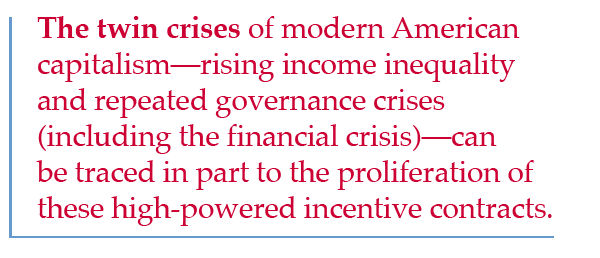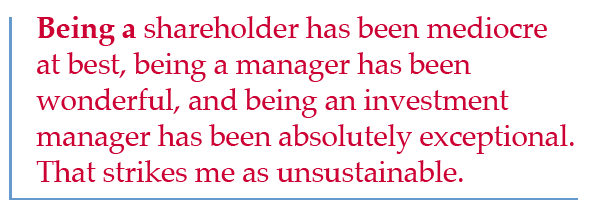An interview with Mihir A. Desai, Mizuho Financial Group professor of finance and professor of law, and HBS’s senior associate dean for planning and university affairs. Read the complete article, “Can America Compete?” (September-October 2012)
Harvard Magazine: The crux of your argument is that governance has broken down on both sides of American capitalism: the managers who run companies, and the institutional investors who in effect own them. Monitoring performance, evaluating it, and holding performance to a standard has fallen short. In what ways, and with what consequences for Americans?
Mihir Desai: The competitiveness of the U.S. economy is connected fundamentally to the productivity of American workers. That productivity hinges on the allocation of all kinds of capital: financial capital, real capital, and human capital, because workers are most productive with the appropriate allocation of capital. That led me to question how those allocation processes are working and the incentives facing managers and investors.
I was struck by how the evaluation and compensation of managers and investors have been transformed over the last several decades: in short, we have decided to outsource that evaluation and compensation to financial markets. If financial markets indicate that these actors have created value, these contracts suggest that they should take a piece of that incremental value. This seems fair and has become a dominant belief on both sides of the capital market. These beliefs are manifest in the rise of equity-based compensation for managers but also in the rise of the alternative-asset industry that relies on a similar logic. Indeed, the rise of the alternative-asset industry—both hedge funds and private-equity firms—has been transformational for global capital markets, and they are predicated in part on this intuition.
I label the evolution of these practices a “financial incentive bubble” because I think they are unsustainable as implemented. As I lay out in my Harvard Business Review article, I think the twin crises of modern American capitalism—rising income inequality and repeated governance crises (including the financial crisis)—can be traced in part to the proliferation of these very high-powered incentive contracts for managers and institutional investors.
HM: Years ago, there was concern that corporate managers did not have the same interests as shareholders, so there was a reformist impulse: give managers stock as an incentive and everyone’s interests would be aligned. You’re saying that reform was too simplistic?
MD: The impulse for such reforms was correct: well-designed instruments can provide for an alignment of interest between shareholders and managers. But implementation of those ideas has become far divorced from that abstraction. In particular, these contracts for managers and investors have made little effort to control for relative performance or for the risks undertaken—and have been implemented over time horizons that are simply too short.
For example, unindexed performance contracts—that award corporate managers stock compensation but don’t try to control for some general level of stock-market or industry performance—are dominant in the U.S. and difficult to reconcile with common sense. Similarly, contracts for investment-management services that don’t measure appropriate benchmarks thoughtfully, or the underlying risks managers are taking, also just don’t make sense.
The related problem is the horizons across which these contracts get implemented. We are trying to measure performance and value creation over very short horizons, even when we know that it’s almost impossible to disentangle skill from luck at such high frequencies. I like to use the analogy of sports because managers and investors like to think of themselves as athletes. There is no great difficulty in disentangling luck from skill in Roger Federer’s game or LeBron James’s game—their performance reflects their effort and skill. That clarity in separating luck from skill is lacking when assessing managers and investors. Only very long horizons can help solve that problem.
It is tempting to view my argument as some kind of an “Occupy” document: these people are getting paid too much. Just to be perfectly clear, I think managerial talent and investment talent are two of the most precious things in a market economy, and I love market economies. High-quality managers and investors should be richly rewarded. My problem is not with the level of compensation, it’s with the form. Contracts that don’t measure performance relative to appropriate benchmarks or that claim to disentangle luck from skill over short horizons can do more harm than good.
HM: What problems do typical, ostensibly market-based, management and asset-manager compensation agreements cause?
MD: If the only adverse result of these contracts was a bunch of windfalls for being lucky, it’s not a problem per se. The real problem is the risk-taking these contracts induce. We know such contracts give rise to risk-taking incentives for people to increase stock prices at shorter horizons by doing things that may not lead to the long-run success of those organizations. That kind of asymmetric contract has been shown to be at the heart of a number of governance problems on the managerial side. The remarkable wealth obtainable simply by influencing short-run outcomes distorts people into decisions that are not in the interest of the long-run shareholder.

In investment management, the similar notion in the alternative-asset industry is predicated on the so-called “two and twenty contract”: alternative-asset managers get a management fee of 2 percent of the asset value annually and 20 percent of investment gains—the “carried interest.” The logic is simple: I give you $100, you make it into $120—therefore, you must have created value and deserve 20 percent of that $20. You get skin in the game as a consequence, and our interests are aligned because you succeed only when I do. That sounds fair and right.
The first problem with that logic is that we need to know how the rest of the market and comparable investments did. Otherwise, that compensation is a windfall. More important, we need to be able to observe the risk and the leverage the investment manager undertook in order to make that $100 into $120. If you don’t observe that perfectly (and you never can), then you are partly giving an incentive for the manager to take on risk—risk that you don’t quantify or penalize for. Making matters worse, we measure their returns and compensate them over a short horizon, further inducing them to take on risks over the short run. Finally, we’re not typically charging for the illiquidity the manager imposes on the ultimate investor when I have to lock up my money inside a fund for many years. We all found out during the financial crisis that illiquidity is very costly. In short, we induce risk-taking on both sides of the capital market by naively structuring these contracts over short horizons and without sufficient attention to the risks being undertaken or illiquidity being imposed.
A guiding principle of the rise of alternative assets is the proliferation of the idea that they can provide “alpha,” or excess returns, to their clients. Indeed, the raison d’être for much of the industry is the belief that alpha is readily quantified and obtained. Many of these claims are difficult to substantiate when one uses an appropriate benchmark for their investments, properly accounts for leverage, and properly penalizes them for the illiquidity they impose on investors. So the final problem is that, to justify these contracts, many of the ultimate investors—pension funds and foundations—are promised alpha that never materializes. Of course, they’re equally culpable because part of the attraction of this promised alpha is the ability to mask their underfunded pensions.
Just to be clear, a considerably smaller alternative-asset industry is likely well justified for investors with true talent. But the claim here is that this industry mushroomed well past what can be justified by their returns, in part because of the naiveté of these contracts and the search for the “free lunch” of excess returns.
HM: So these incentives lead to behaviors that may not be productive in the long term and can also lead to crises?
MD: Yes. One of the things I wanted to do is provide an alternative history of the financial crisis. In my article, I discuss the rapid growth of the alternative-asset industry in the late 1990s and early 2000s in response to very low interest rates after the Internet bubble. I use contemporaneous accounts to show that the rise of the alternative-asset industry triggers risk-taking inside traditional Wall Street establishments as they compete to hold on to their people and retain customers. Wall Street saw the rapid growth of an operating model with even more operating leverage and profitability than their own—and came to mimic it by providing more risk capital to their own traders and employees.
It’s tempting to say there’s some big ethical problem here—this generation just doesn’t have the morals of the last one. I think this is naive. These contracts are giving rise to the risk-taking and short-term thinking. Young investment managers could access completely mind-blowing wealth based on six or 12 months of performance, because as soon as they produce those results, more funds start to flow in and before you know it, they are running another large fund and after another 12 months of reasonable returns they are going to be in a world of compensation they could never have imagined. That’s going to give rise to problematic risk-taking.
To return to capital allocation for a moment: financial capital is being allocated by these investors, real capital is being allocated by corporate managers with similarly distorted incentives, and then human capital is being allocated when we see our young graduates choose their fields in response to these skewed rewards. When the structure of relative rewards gets so out of whack, in part because of these naive contracts, then people start making human-capital decisions that are likely not socially optimal. And, of course, the allocation of talent, particularly way out in the tail of the distribution of talent, matters enormously for all of us.
HM: Are these problems susceptible to regulatory reform, changes in taxation, or better ethical education for managers?
MD: I am somewhat pessimistic about the usual recommendations. Handwringing about ethics is not my preferred solution because it obscures the critical role of incentives as you see them playing out in society at large. Indeed, these are often very good people responding to crazy incentives.
Using regulatory or tax instruments is likely problematic. As a public-finance scholar, I’m keenly aware of our fiscal problems, and reforms should be geared toward those problems rather than fine-tuning governance. Indeed, fine-tuning our tax system to target compensation practices can lead to unforeseen consequences. The one exception that I think is advisable is correcting the characterization of carried interest employed in the alternative-asset industry as capital income rather than labor income. This preferential treatment of earned income effectively increases the subsidy toward these high-powered incentive contracts.
I think the first step in improving things is popping the underlying myths—that we can use financial markets naively to measure performance over short horizons and that excess returns are easily measured and obtained if we just put the right incentive contract in front of a smart person. In fact, markets are roughly efficient and alpha is hard to measure and fairly scarce. And discerning who is a good manager or good investor can take many, many years—contracts need to be restructured to reflect that.

Second, we have to awaken institutional investors, particularly large pension funds, foundations, and endowments, to their responsibilities. In effect, by outsourcing performance evaluation and compensation to financial markets, these institutions have abdicated their fundamental responsibility and achieved a sort of plausible deniability. Board members can say: “I don’t have to evaluate my manager because I have a neutral, objective measure of performance—the stock price. I didn’t pay the manager a lot of money—I just made sure our interests were aligned.” Similarly, managers of large pension funds can say, “I didn’t lose any money. I just gave your assets to the best outside investment managers, or the best funds of funds, so you can’t fault me for any losses.” That is why this problem is so difficult—we can’t expect markets alone to solve this because the underlying problem is that there are monopolistic providers of pension services. The ultimate governance providers in our economy are the large institutional investors—state and corporate pension funds, endowments—and you can’t unseat them.
Awakening institutional investors is the best chance we have to fix this. That is starting to happen. It could happen much more—for example, institutions should be playing much more active roles in compensation practices by reinserting judgment into executive compensation, challenging existing compensation arrangements, and significantly lengthening the horizons over which managers and investors are evaluated.
On the alternative-asset side, there is much to be said for creating a uniform system for reporting results so asset managers can no longer live in Lake Wobegon where every manager is in the top quartile of performance. Recent developments in Canada are also instructive: their pension funds have figured out that they can disintermediate alternative-asset investors and do transactions themselves. Somehow, in the U.S., we’ve come to a place where it’s easier to pay outside alternative-asset managers more money than an internal pension-fund manager will ever see. The Canadians have shown us the opportunity to reclaim a chunk of that investment function. Finally, requiring a fuller funding of pensions would help enormously—so the temptation to swing for the fences by investing in asset classes that promise alpha will become restricted. The easiest way to avoid the reckoning of an underfunded pension is to assume you can make higher returns by allocating more and more assets to individuals who promise alpha. So the problem gets worse as those returns turn out to be illusory.
For people who care about shareholder capitalism, the past 15 years have to be deeply worrying. Being a shareholder has been mediocre at best, being a manager has been wonderful, and being an investment manager has been absolutely exceptional. That strikes me as unsustainable. I think the proliferation of these naive contracts via the financial-incentive bubble helps explain these patterns.
Next: The Workforce
“All the other things we used to think about as a social contract…”
Thomas A. Kochan, Bunker professor of management, MIT’s Sloan School of Management, and co-director of the MIT Institute for Work and Employment Research











